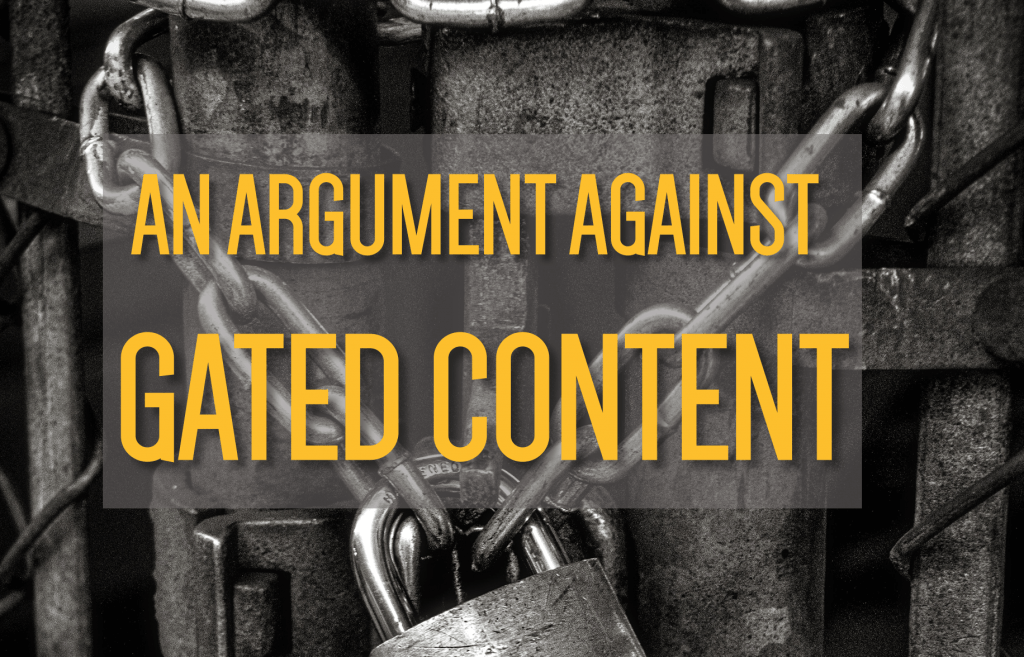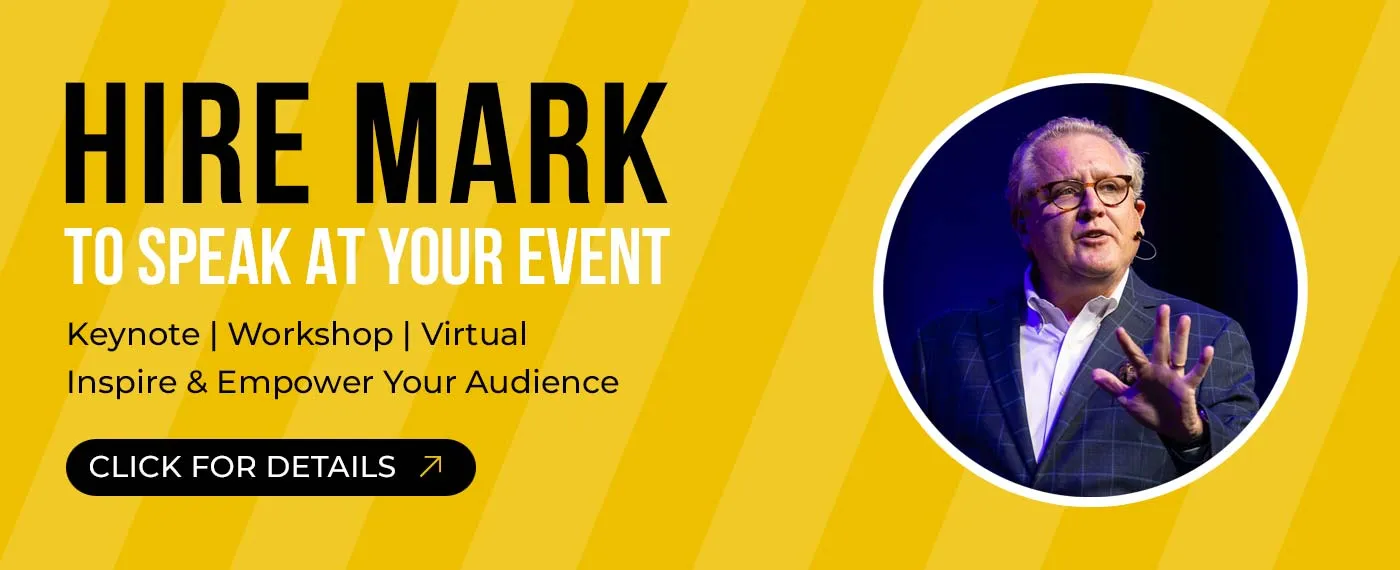
One of the most popular methods of generating leads is to “gate” your most valuable content. Gated content refers to the practice of having a website visitor opt-in to the content by providing an email address in exchange for a document of some sort.
Gated content can be a legitimate way to increase a mailing list with potential leads. But I’m going to challenge conventional wisdom and this marketing “best practice” by suggesting a new view of gated content in the context of our current, challenging business conditions.
Many marketers point to the high investment in exceptional content and that the exchange of an email address is the only way to get any value in return. What I would like you to consider is that by making it difficult for people to see your content, you’re actually leaving value on the table.
The current state of gated content
Here are a couple of points to provide a perspective of our marketing world today.
- People hate gated content. Even marketers who gate their content know this. Research shows more than 90 percent of the people interested in the content abandon the sign-up process because they don’t trust what happens next to the email address.
- Many marketers justify gated content as a fair value exchange but research shows this is not true. Consumers state they are “resigned” to annoying marketing practices and more than half immediately unsubscribe to a site even after they opt-in.
- Acquiring email addresses in exchange for gated content may not be compliant with emerging new privacy laws.
- We are clearly in an era of Content Shock where the competition for content views is vicious. One of the visible manifestations of this trend is BuzzSumo research showing how social shares on a topic decline precipitously as a subject becomes saturated. In other words, unless you are among the first to create content on a topic, it is extremely difficult to get your content to be seen and shared.
A new content marketing philosophy
In my book The Content Code, I provide an updated view of content marketing strategy.
The philosophy behind the book revolves around the practical idea that the economic value of content that is not seen and shared is zero. Therefore, we must develop competency in not just producing content, but igniting it so that is seen and shared by the most people possible. The economic value of content marketing is not in the content, it is in the transmission of the content.
Creating great content is no longer the finish line, it is the starting line. The book outlines six possible strategies to remove barriers and give your content the best possible chance to flow and reach the most people possible.
Obviously requiring people to provide an email address to get a piece of content is about the worst thing you can do in this new view of “content success.” In essence, gated content places a stop sign in front of your content flow. It is an anachronistic way of thinking.
The value exchange
The decision to provide a barrier before your content must boil down to this: Are you going to receive more value from a trickle of people providing their email, or a flood of people seeing and sharing the content? Let’s look at a case study to try to figure this out.
My talented friend James Carbary provided this interesting example of how the gated content value exchange played out for his own business. He wrote:
“It took five months for us to get 295 people to sign up for the gated opt-in offer on our website. This progress seemed incredibly slow, so I tried something different.
“A couple weeks ago, I published a status update on LinkedIn explaining that I’d developed a list of 67 content topics that work well on that site. If people wanted the ideas, I asked them to leave a comment that said ‘I want it.’ Then I explained that I would turn the ideas into a free PDF if 100 people left a comment.
“In three hours I had over 150 comments. That post has now been viewed more 160,000 times, and 692 people left a comment saying they wanted the content ideas. We turned the ideas into a PDF, and replied to every comment with the link.
“In five days, my content spread to 692 people, compared to to 295 people in five months. We collected ZERO email addresses through the LinkedIn content but I’m beginning to see why un-gated content might be a smarter strategy.”
The case for amplification
James told me that the most tangible benefit of the ungated strategy was a connection with a high-potential customer and a podcast interview with this powerful new connection.
There are also some implied benefits in this un-gated content example that would probably be easy to track down:
- Of the 692 people who asked for the content, how many were entirely new LinkedIn connections for James? He didn’t get an email address, but he did get a signal of interest and arguably these new LinkedIn connections might be more valuable in the long-term than an email address.
- How many of the 692 people responded to a call to action at the end of the report and visited a website, or organically subscribed to receive more content?
- How many shared the free content with more people inside and outside the company? How much additional flow did this receive because it was free?
Even if the percentage of people sharing content is the same whether it is gated or ungated, you are going to reach many more people with a base of fans numbering 692 versus 295. And that is happening in a matter of days versus months!
Finally, I have shared James’s story, linked to his website and shared his story. I can’t recall ever linking to gated content that would require my readers to sign-in to something. So the benefit created by this post would have never happened if he didn’t give his content away for free.
If you subscribe to my philosophy that the company that moves the most content will win, there is no question that un-gated content provides more potential value. His content is moving like crazy.
Branding and trust
I was discussing this issue with a colleague and she said “gated content just annoys me. Why would a brand want to be annoying? The company is making me distrust them because I have no idea what will happen to that email address.”
I think this an important consideration that is not normally part of the gated content debate. Most marketers are preoccupied with trying to get value from a single piece of content without considering the cumulative impact on the view of the brand.
A simple thought exercise: If you are in a hotly-competitive field (like SEO or digital marketing) and one company has gated content and the other gives their best content away for free, which one will have a more positive brand view?
The research supports un-gated content
Roger Dooley is an expert in the field of neuroscience and marketing. In a post, he points out that from a psychological perspective, un-gated content is the undisputed content champ. Roger writes:
Requiring a user to give up his info before viewing good content is a reward strategy – give us your info, and we’ll reward you by letting you see our wonderful content. This is an appealing strategy at first glance – 100% of the people who use the content will have completed the form, and the information should be a powerful motivator for visitors to proceed.
In fact, most users confronted with a form won’t complete it. If they arrived at the site looking for some specific information, they will likely hit the back button and see if they can access it without the aggravation of form completion and without the risk of getting spammed later.
It turns out that a reciprocity strategy works better – give them the info they want, and then ask for their information. The research shows that twice as many visitors gave up their information if they were able to access the information first. It’s counterintuitive, perhaps, but even though these visitors were under no obligation to complete the form, they converted at double the rate of visitors seeing the “mandatory” form.
The neuromarketing takeaway here is that if you invoke reciprocity, you’ll be working with the way our brains are wired and will be more likely to get your visitors to do what you want them to. (And, as an added bonus, your SEO person will be happy that along with your visitors, Google will be able to see your content, too!)
The issue of measurement
A compelling argument for requiring an email to access content is measurement. Providing a tangible demonstration of the value of content marketing is difficult. There is some elegance in telling a client or your boss that an eBook (or whatever) resulted in a countable number of sign-ups that might be stretched into a claim of “leads.”
Measuring content marketing is damn hard. Most can’t do an adequate job. I acknowledge that gating your content may be the politically correct thing to do even if the strategy is flawed based on today’s market realities.
However, I think “social shares” is a more powerful measurement than “number of email addresses.” An email address may translate into … nothing. But a social share represents organic advocacy, better than any ad you could pay for. I understand that many people still don’t understand that.
An unpopular view
I’ve had many negative reactions to the idea of un-gating content. Here is one of them:
I think if you understand Funnels and the importance email still plays in the sales process then you wouldn’t have written this article. It’s not just about sharing good content — it’s also about turning your audience into customers. How do you do that when you never ask for an email address to move the relationship forward? It’s all about moving folks through your customer journey.
I would politely suggest this is an anachronistic view of the world that works in “funnels.” It’s not “your customer journey.” It’s THEIRS.
Most marketing today is not your marketing — it’s the sharing of information that’s going on without you. And if you have a gate, that clogs up the information you want shared. Let’s do the math and generously assume that 10% of the people who see your post will call for an appointment. We know that 90% of the people who come across your gate will go away. So for every 100 potential customers, you get 10 content views, and one call.
If I un-gate the content, I get 100 views and 10 calls. I am 10x more productive. Also, I have 100 people potentially SHARING my article instead of 10 for you.
BTW, what are you going to do AFTER getting the email address? Spam your way to glory? That’s why people don’t trust gated content in the first place. You’re part of the problem.
I realize it’s a new way to think, but I can’t imagine a business today that works so hard to get customers to their site to view content and then be willing to let 90% of them walk away. If you ask people for an email AFTER they see the content, research shows it works better.
In any scenario, the numbers work in my favor, not yours.
A simple rule of thumb
One of the themes in my recent writing is that we have lost our way in marketing. Often, those setting the standards we follow aren’t marketers; they are SEO experts, statisticians, and IT professionals. I am not diminishing the worth of these resources at all, but maybe a statistical evaluation is not always the best guidepost for a marketing decision. Perhaps we need to get our heads out of dashboards and spreadsheets and look at what is really happening with our customers in the real world.
Just because something seems favorable because of an A/B test or some new research into a backlink strategy, it doesn’t mean we should do it … especially if people hate it.
So I’ll end this post with a simple piece of advice. People hate gated content. Don’t do things people hate.
Instead, dig deep to discover what your customers love. Now go do that thing better than anybody else. That’s going to be marketing that works.
 Mark Schaefer is the executive director of Schaefer Marketing Solutions. He is the author of some of the world’s bestselling marketing books and is an acclaimed keynote speaker, college educator, and business consultant. The Marketing Companion podcast is among the top business podcasts in the world. Contact Mark to have him speak at your company event or conference soon.
Mark Schaefer is the executive director of Schaefer Marketing Solutions. He is the author of some of the world’s bestselling marketing books and is an acclaimed keynote speaker, college educator, and business consultant. The Marketing Companion podcast is among the top business podcasts in the world. Contact Mark to have him speak at your company event or conference soon.
Follow Mark on Twitter, LinkedIn, YouTube, and Instagram.
Illustration courtesy of Unsplash.com


